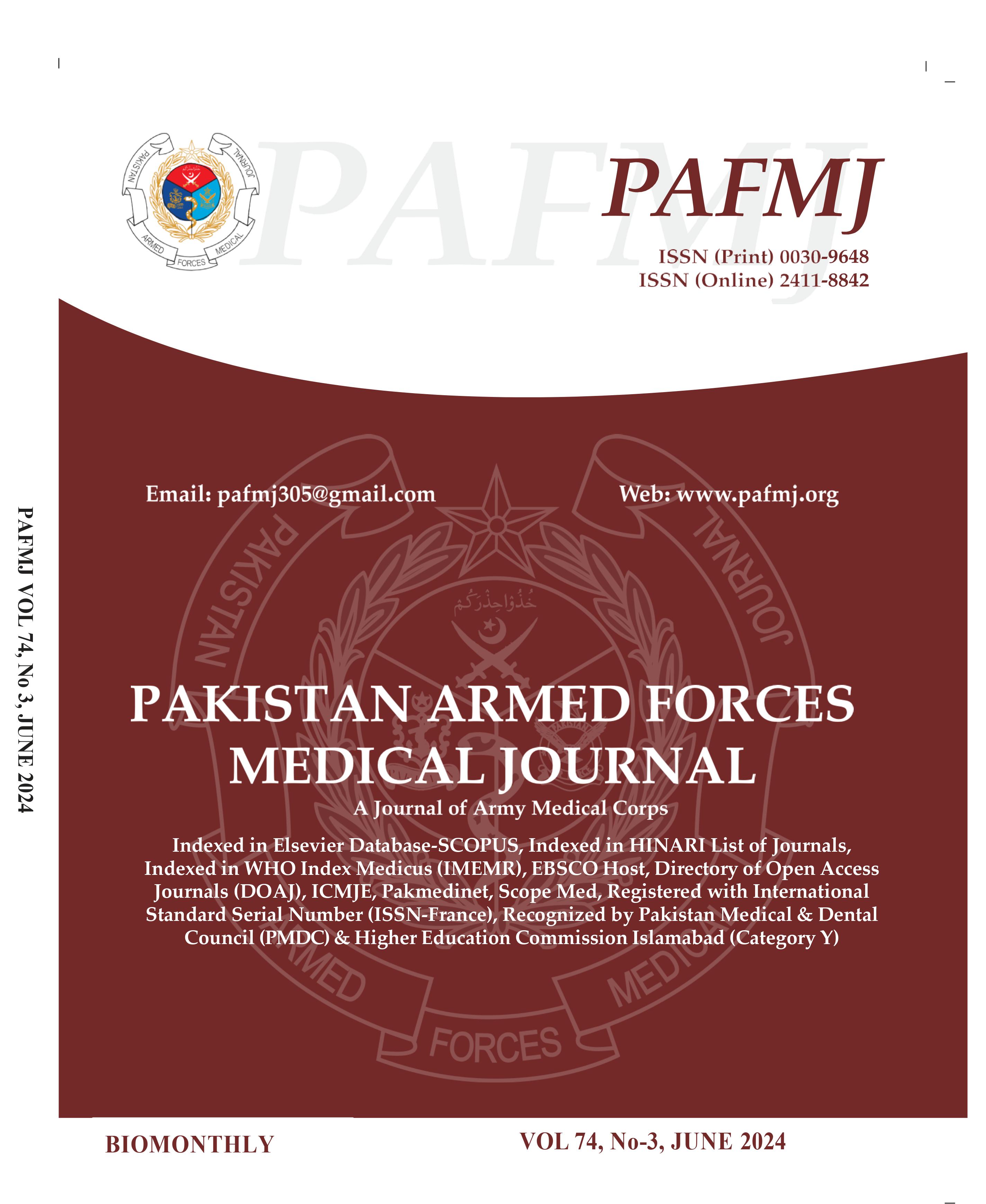Clinical Response of EMLA Cream in Decreasing Peripheral Cannulation Pain in Children
DOI:
https://doi.org/10.51253/pafmj.v74i3.8826Keywords:
Anaesthesia, Cannulation, Eutectic, Peripheral, VenipunctureAbstract
Objective: To assess the clinical response of EMLA cream (Eutectic Mixture of Local Anaesthetics; 2.5% Lidocaine/2.5% Prilocaine) in decreasing peripheral cannulation pain in children.
Study Design: Quasi-experimental study.
Place and Duration of Study: Combined Military Hospital, Rawalpindi Pakistan, from May to Aug 2021.
Methodology: This study was conducted on 80 paediatric patients who were classified as American Society of Anesthesiologists (ASA) Grades I and II and selected using non- probability consecutive sample. They underwent peripheral cannulation to maintain intravascular access for surgical procedure. The forty children in EMLA Group (Group-A) were applied 2.5 ml EMLA cream for 60 min, covered by Tegaderm® over suitable vein, while the 40 children in Control Group (Group-B) received no local anesthetic cream. Participants rated pain during venipuncture on Visual Analog Scale (VAS 0–10; 0, no pain; 10, intolerable pain).
Results: Out of 80 patients equally divided into two groups, 40(50%) were males, while 40(50%) were females. The patients included in our study had mean age of 7.35±1.5 years. In EMLA group the mean score of pain was 1.5±0.87 compared to the Control group (mean score = 7.4±1.4; p=0.001).
Conclusion: The result of our study suggests that EMLA cream is more efficacious in decreasing venipuncture pain than if no local anaesthetic cream is applied.
Downloads
References
Jafari H, Zeydi AE, Khani S, Esmaeili R, Soleimani A. The effects of listening to preferred music on pain intensity after open heart surgery. Iran J Nurs Midwifery Res 2012; 17(1): 1-6
Barker NJ, Jones M, O'Connell NE, Everard ML. Breathing exercises for dysfunctional breathing/hyperventilation syndrome in children. Cochrane Database Syst Rev 2013; (12): CD010376. https://doi.org/10.1002/14651858.CD010376.pub2
Fein JA, Zempsky WT, Cravero JP, Shaw KN, Ackerman AD, Chun TH, et al. Relief of pain and anxiety in pediatric patients in emergency medical systems. Pediatrics 2012; 130(5): e1391-405. https://doi.org/10.1542/peds.2012-2536
Cozzi G, Valerio P, Kennedy R. A narrative review with practical advice on how to decrease pain and distress during venipuncture and peripheral intravenous cannulation. Acta Paediatr 2021; 110(2): 423-432.
https://doi.org/10.1111/apa.15526
Bahar E, Yoon H. Lidocaine: A Local Anesthetic, Its Adverse Effects and Management. Medicina 2021; 57(8): 782.
https://doi.org/10.3390/medicina57080782
Lillieborg S, Aanderud L. EMLA anaesthetic cream for debridement of burns: a study of plasma concentrations of lidocaine and prilocaine and a review of the literature. Int J Burns Trauma 2017; 7(6): 88-97.
Jorisa D, Jeroena V, Jolitab B Lidocaine spray as a local analgesic for intravenous cannulation: a randomized clinical trial, Eur J Emerg Med 2019; 26(1): 24-28.
https://doi/10.1097/MEJ.0000000000000496
Effendy I, Gelber A, Lehmann P, Huledal G, Lillieborg S. Plasma concentrations and analgesic efficacy of lidocaine and prilocaine in leg ulcer-related pain during daily application of lidocaine-prilocaine cream (EMLA™) for 10 days. Br J Dermatol 2015; 173(1): 259-261. https://doi.org/10.1111/bjd.13605
Lander JA, Weltman BJ, So SS. EMLA and amethocaine for reduction of children's pain associated with needle insertion. Cochrane Database Syst Rev 2006; (3): CD004236.
https://doi.org/10.1002/14651858.CD004236.pub2
Arendts G, Stevens M, Fry M. Topical anaesthesia and intravenous cannulation success in paediatric patients: a randomized double-blind trial. Br J Anaesth 2008; 100(4): 521-524. https://doi.org/10.1093/bja/aen003
Danese E, Tarperi C, Salvagno GL, Guzzo A, Sanchis-Gomar F, Festa L, et al. Sympatho-adrenergic activation by endurance exercise: Effect on metanephrines spillover and its role in predicting athlete's performance. Oncotarget 2018; 9(21): 15650-15657. https://doi.org/10.18632/oncotarget.24584
Goldstein DS. Adrenal responses to stress. Cell Mol Neurobiol 2010;30(8):1433-1440.
https://doi.org/10.1007/s10571-010-9606-9
Huang Y, Chai S, Wang D, Li W, Zhang X. Efficacy of Eutectic Mixture of Local Anesthetics on Pain Control During Extracorporeal Shock Wave Lithotripsy: A Systematic Review and Meta-Analysis. Med Sci Monit 2020; 26: e921063.
https://doi.org/10.12659/MSM.921063
Chugh A, Singh S, Khatana S. The Clinical Efficacy of EMLA as a Topical Anesthetic Agent Instead of Palatal Injection During Maxillary Dental Extractions: A Randomized Controlled Trial.J Maxillofac Oral Surg 2021;22; 1-6
https://doi.org/10.1007/s12663-021-01633
Friedman PM, Mafong EA, Friedman ES, Geronemus RG. Topical anesthetics update: EMLA and beyond. Dermatol Surg 2001; 27(12): 1019-1026.
https://doi.org/10.1046/j.1524-4725.2001.01855.x
Gyftopoulos KI. The efficacy and safety of topical EMLA cream application for minor surgery of the adult penis. Urol Ann 2012; 4(3): 145-149. https://doi.org/10.4103/0974-7796.102658
Rogers TL, Ostrow CL. The use of EMLA cream to decrease venipuncture pain in children. J Pediatr Nurs 2004; 19(1): 33-39. https://doi.org/10.1016/j.pedn.2003.09.005
Eichenfield LF, Funk A, Fallon-Friedlander S, Cunningham BB. A clinical study to evaluate the efficacy of ELA-Max (4% liposomal lidocaine) as compared with eutectic mixture of local anesthetics cream for pain reduction of venipuncture in children. Pediatrics 2002; 109(6): 1093-1099.
Downloads
Published
Issue
Section
License
Copyright (c) 2024 Sana Tariq, Rao Ali Shan Khan, Arooj Shahid, Hassan Tariq, Tanveer Ahmed Khan, Ahmed Bilal Khalique

This work is licensed under a Creative Commons Attribution-NonCommercial 4.0 International License.















